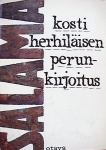Economy: bad, bad
| It's very easy to find reports of economic slump or even depression these days in Korea. The basic line is that exports are doing quite well but domestic demand and consumption is poor. Joongang Ilbo tells that small companies have it increasingly difficult to pay back loans that banks have been dishing out in a "don't ask manner" (mutchi ma taech'ul). Lower consumer demand --> price cuts to keep up some kind of sales, very slim margins, businesses barely existing, increase of overdue loans. "Chajangmyôn, tonkkasû 2000W, pork ribs for 3 persons 9900W"; these are some pretty cheap prices being the consequence of competition reported in a eatery street in Noweon-gu. Besides restaurants, the other branch in difficulties is lodging; prices been cut to half in some places. 음식, 숙박, 부동산 임대업의 부실은 2002년 월드컵을 전후해 이미 예고됐다. 외환위기 이후 명예퇴직자가 급증한 데다 월드컵을 앞두고 음식.숙박업 창업 붐이 일었다. 여기에다 은행들이 이들 업종에 대한 대출 경쟁에 나서 거품을 키웠다.Question: how wide is this trend? The only piece of statistics quoted is the increased percentage of overdue loans in one bank. The difficulties of restaurant and lodging businesses have been reported already for a long time (my own post from May) Economy 21, the economic weekly of the Hankyoreh company, has a good article on the effects of the increasing poverty on the overall economy. The head of the Korean Research & Consulting Institute of Poverty (한국빈곤문제연구소) tells that people seeking consultation for their problems no longer have that specific smell of poverty as before - an interesting observation in itself: 남의 얘기가 아니다. 내수시장의 침체가 이어져 자영업자, 중소기업이 속속 무너지면 당신도 그 계층에 들어갈 수 있다. “신빈곤층한테선 스킨 향기가 난다”고 류정순 한국빈곤문제연구소장은 말한다. “예전엔 가난한 사람들한테서 된장 냄새가 났어요. 몸을 잘 못 씻고 옷도 자주 갈아입지 못하는 사람한테서 나는 독특한 냄새죠. 요즘 상담소를 찾아오는 사람들은 학력도 높고 자존심도 높아요. 냄새도 좋고.” 이들은 대개 사업 실패 등 이러저러한 이유로 신용불량자가 된 사람들이란다. - The importance of the middle class (in Korean "stratum" (kyech'ûng) and the low-income stratum for the domestic consumption; the high-income stratum itself insufficient to maintain domestic consumption; also a lot of the consumption of the high-income stratum is directed abroad - 23% of urban households see no hope to pay back their debts; - Increase of the poor stratum (those with income less than half of the median income): 1994 8.8%, 1996 9.7%, 2001 12% - Middle class getting smaller; those within 70-150% of the median income were 55% in '94, and 50.5% in '01. High income stratum (more than 150% of the median income) stayed around the same: 1994 21%, 1999 23.3%, 2001 22.7%. - Lack of investment; the portion of property invested in stock etc small, even compared to Japan; Because of the increasing risks concerning the low-income stratum, the bank deposit interest rates have become less profitable, and the high-income and wealthy stratum faces losses - The indiscriminate credit card use by the low-income stratum and the subsequent unsolvable debts end up becoming the burden of the wealthy stratum with investments in card companies, and (ironically) a kind of an income transfer: 그런 현상은 2003년 신용카드 대란 때 이미 일어났다. 당시 카드채 투자자들은 보유채권값 폭락으로 매도 때 큰 손해를 봤다. 자산가들의 금융자산을 굴리는 투자기관들도 카드채, 카드주 폭락으로 적잖게 손실을 냈다. 저소득층이 무분별하게 카드 신용을 사용한 대가를 카드채를 보유한 자산가가 진 셈이다. 오석태 씨티그룹 글로벌마켓 이코노미스트는 “카드사 대손충당금은 하류층에 대한 상류층의 소득 이전”이라고 지적한다. 빈곤층과 자산가층은 보이지 않는 끈으로 묶여 있는 셈이다. ‘이자’라는 끈 말이다.Update. Choson Ilbo has a piece which tells that the nominal interest (myôngmok kûmni, nimelliskorko) is lower than inflation. 15일 통계청과 한국은행에 따르면, 지난 7월을 고비로 월별 소비자물가 상승률이 예금 금리의 지표인 평균 저축성 수신 금리를 추월, 월별 실질금리가 마이너스를 기록할 것으로 추정된다. 올 들어 3%대 초반에 머물던 소비자물가 상승률이 7월 들어 4.4%로 수직 상승했지만 은행권의 저축성 수신 금리는 지난 5월 이후 연 3.8%대를 기록하고 있기 때문이다. Categories at del.icio.us/hunjang: Koreaneconomy ∙ money ∙ stratification |


Comments to note "Economy: bad, bad" (Comments to posts older than 14 days are moderated)
Write a Comment